Media | Articles
After 30-year trip, psychedelic Citroën reunited with its artist

Today, rappers might spit a few bars about getting a new custom wrap on their Lamborghini. Back in the day—when the day was the ’60s, and long before anyone coined the term “art car”—it was fashionable for rock stars to have their vehicles custom-painted to stand out. A more humble Citroen concerns us today, but let’s set the stage with the more famous examples first.
Beatle John Lennon may have sparked the trend with his 1965 Rolls Royce Phantom V, which he custom-ordered from the factory and had equipped with a portable television set, an eight-track tape player, and a Phillips turntable for playing 45s. After the Rolls’ paint got damaged during the filming of How I Won The War, in 1967 Lennon had the limo painted a bright yellow with Romany-style embellishments.

Though done in a classical style, the ornamental painting fit well with the developing, psychedelic aesthetic of the era. Bandmate George Harrison had his Radford-converted Mini Cooper S painted with Tantric art by Dutch artists Simon Posthuma and Marijke Koger, who worked collectively as “The Fool.” Harrison’s Mini is not just a Beatle’s car; it’s a Beatle movie car, having appeared in Magical Mystery Tour.

Underground LSD chemist and Grateful Dead patron of the Grateful Dead gave the band’s 1949 International Harvester M5 pickup truck used to transport gear to gigs a swirling, colorful paint job.

Janis Joplin, whose “friends all” drove Porsches, gave her roadie Dave Richards $500 to give her 356 a truly psychedelic paint job that Richards titled The History of the Universe.
Marketplace
Buy and sell classics with confidence
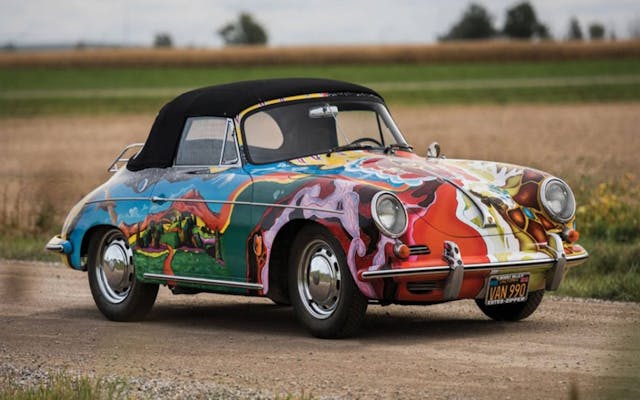
Even automotive upstart (at the time) Honda recognized the psychedelic paint job trend, publishing an ad with a “hippie chick” complete with headband, embellishing a Z600 coupe with colorful swirls.

Lennon’s Rolls-Royce is now in a Canadian museum. It is reported that the paint job, which apparently wasn’t done with automotive paint, is deteriorating. After the Mini appeared in The Magical Mystery Tour movie, Harrison gave it to his good friend and fellow car enthusiast Eric Clapton. The guitarist proceeded to repaint it before returning it to Harrison at some point in the 1970s. It’s not clear exactly when, but at some point after the Mini was returned, the Tantric paint job was recreated, though not exactly, using old photographs and stills from the movie.
Likewise, if you should see Janis’ Porsche when it is sometimes on display at the Gilmore Museum, the paint job isn’t Richards’ original work. After Joplin’s death the car eventually ended up with her brother Michael, who used it as a daily driver. With the custom paint deteriorating and the value of 356C models appreciating, Micheal Joplin decided to restore it to its original dove grey color. In the 1990s, though, Michael and his sister Laura decided to commission two artists to recreate The History of the Universe. Owsley’s IH truck has never been repainted, but having sat in the California sun for more than a half century in many areas his custom paint has bleached to primer.
Can you see a pattern?
While famous cultural icons like the vehicles above are no longer original, sometimes you get lucky and run into an original, period correct hippie car. Mike Mullen’s Citroën 2CV may not be a cultural icon like Janis Joplin’s Porsche, but it’s undoubtedly a piece of (counter) cultural history.
***

For a guy with tie-dyed sympathies Mullen has a very straight job. He’s a court officer, which is how he came to find the Peter Max–esque little French car. He was inspecting a foreclosed, abandoned home to determine if any personal property needed to be removed. On the estate there was a garage and a small, barn-like structure, both secured and locked. The house was filled with trash, and Mullen didn’t expect to find anything of value in the outbuildings.
Once he cut the lock and the light of day entered the garage, he discovered four rather interesting automobiles, none of which he recognized, all parked sideways. There was a red convertible roadster, a wedge-shaped coupe, a little orange sports car, and something—he could just barely make it out—that was hand-painted.

Breaking into the barn, Mullen found a very nice drophead Austin Healey, and a yellow sports car similar to the orange one. In the loft there were spare fiberglass bodies, and a hardtop and spare parts for the Healey.
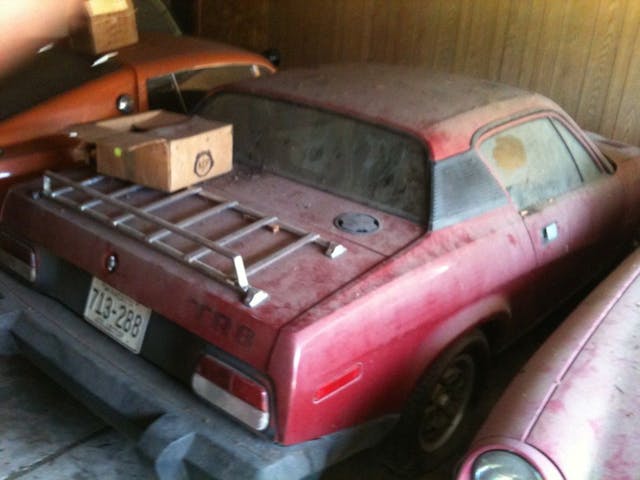
Mullen had a bit of a mystery on his hands. Before the court could dispose of the property, the owner of those cars needed to be located. He took pictures of everything, resecured the buildings with new locks, and let the law office know that it was going to take a few days to clear things out. He knew that the cars weren’t just abandoned. The law office provided phone numbers and the address of the previous owner of the property. There was no answer on the phone so Mullen drove the ten miles to the address. Nobody was home, but as he was about to leave the previous owner showed up. Mullen told him about finding what he figured were some valuable cars. The man said the cars weren’t his; they belonged to a Pam Hansen and her late husband. He gave Mullen her phone number.
When Pam answered the phone, and after Mullen explained the reason for his call, he could tell from her tone of voice that this was a difficult matter for her. She said she’d been avoiding moving the cars because of the memories they evoked. They belonged to her husband, Paul, who had doted over them. The Hansens had moved to the Detroit area from Minnesota in the early 1990s and rented the storage spaces for Paul’s cars, but he died of cancer just five years after the move and they never really got a chance to enjoy the cars in their new surroundings. Pam felt it easier to simply pay the rent than deal with the emotion of selling her late husband’s treasured collecton.
While Mullen couldn’t identify all of the cars, Pam knew exactly what Paul had: a ’61 Austin-Healey 3000 with both hard and soft tops; two Saab Sonetts, both of which he raced—an orange Sonett 3 and a yellow Sonett 4; a ’74 Jensen Healey convertible; a Triumph TR-8 hardtop; and the decorated car, a ’61 Citroen 2CV.
Mullen tried to make the process as easy as possible on Pam. He filled the tires, packed up all the parts, removed the cars from their buildings, and arranged for tow trucks to move the cars to Pam’s house.

In the process of moving the cars, Mullen asked Pam whether she had thought of selling any of them. Mullen had been thinking of getting a small British roadster like a Triumph TR6 but when Pam asked which interested him, he immediately said the art car. He was intrigued and wanted to find out who painted it and what the artist’s story was. Pam wasn’t ready to sell the Deux Chevaux but did say she was willing to sell the Jensen, which satisfied Mullen’s roadster desires. The other Healey, the Austin-Healey 3000, was decidedly “not for sale!”

After taking delivery of the Jensen, Mullen started cleaning out the results of 17 years of rodents making their residence in the car. The body was sound and the engine turned over, so he started doing some mechanical work to get it running. A few weeks later he received a phone call from Pam who thought he would make a good caretaker for the 2CV. They came to an agreement on price and Mullen picked it up, initially storing the little car under a tarp as his garage space was occupied by the Jensen, which was not yet running.

Mullen regularly had breakfast at a restaurant with his friend Tom, a mechanic who had immigrated from Syria. Out of the blue, Mullen asked Tom if he knew anyone who had experience with the Citroen 2CV. Tom’s face lit up and he recalled that as an 18-year-old he worked as a mechanic for a business man who had purchased a fleet of 17 surplus 2CVs from the United Nations. As he repaired them, his boss would flip them at a profit. Mullen not only had a very cool car; he already knew someone who could get it running.

Like the Jensen, there were signs of mice all over the Citroën. More troubling was the fact that raccoons had nested in the 2CV’s fabric roll-up roof—that is, until the material rotted. Then they nested on the car’s upholstery, until that rotted as well. Everything that could absorb odor had to be removed and discarded, which meant most of the wood, cloth, and rubber. Eventually Mullen got the car clean. Then a complete stranger caused a pause in the action.
Someone stopped after driving by Mullen’s house. He introduced himself as an artist, saying that the car appeared to be done in the style of famed psychedelic artist Peter Max. If the car was truly the product of Max’s handiwork, it could be worth a considerable sum. Mullen contacted Max’s studio in New York, who told him that as cool as the hippie car was, it wasn’t a Peter Max objet d’art. He informed Pam of his disappointed findings, and she said she’d look into Paul’s records to see if anything could help track down previous owners, or even, hopefully, the artist.

In the meantime Mullen sold the Jensen Healey to his neighbor, a Corvette enthusiast who proceeded to finish the restoration.

Weeks later Mullen got a phone call from Pam, who told him that she found a transferred title from 1975 and that the previous owner was a woman who lived in Richfield, Minnesota. With diligent searching, Mullen eventually found her phone number. Though it’s always a bit awkward when your phone conversation starts out with “You don’t know me, but…,” Mullen persevered. He found out she was actually the sister of the previous owner, Terrance, described as reclusive. She gave him a phone number.
He called and left a message. A few days later, he got a call back. After proving that he wasn’t some kind of government agent, Mullen asked about the Citroën and the paint job. Terrance didn’t know how the car got painted, just that he had bought it off a kid who sold it because he couldn’t get the Citroën started started. Terrance had spent about a week getting the 2CV running, driven it for about 6 months, and flipped it for a nice profit.
After more back and forth, Terrance revealed that he bought the car “right in Richfield.” However, he didn’t remember the name of the person who sold it to him. He also didn’t particularly appreciate the art work; if he had kept it, he would have likely stripped and repainted it. He did remember that the previous owner had been an art student, who said that the car was painted at an art school.
Which student? What school? Mullen first tried using the local Richfield newspaper to track down the painter, but the few leads he got didn’t pan out. He decided to take things up a notch. He contact Minneapolis’ Star Tribune, thinking that the big-city daily would be interested in a human interest story and that its wider circulation might generate actual results.
Mullen reached Star Tribune human interest editor Gail Rosenblum, who ran a synopsis of the story so far and asked readers if they knew who the artist was. Four hours after the story ran in the morning edition Rosenblum received a phone call from a man named Richard Bolger (who stylized his first name “dik”) who said that it was his car when he was a teen. Bolger, a stained glass artist married to another artist, was now the father of a teen himself. “This is just wild,” Bolger e-mailed Rosenblum. “My brother and I painted that car and I have some wonderful stories… That was a slice of my history.”
Bolger was introduced to Citroëns by his older brother Jack, now deceased. “He drove these cars and just loved them,” Bolger said of Jack, who brought the 2CV home after a trip to the continent. The two-cylinder car wasn’t exactly a muscle car. “If you were lucky on a downhill slope, you could go 45 miles per hour,” Bolger reminisced.
Once the Citroën arrived in Minnesota, the brothers took it up to their grandfather’s house near Lake of the Isles and the two of them along with a student at the Minneapolis College of Art and Design started painting it. “We spent hours and hours and hours of that beautiful summer painting this thing,” Bolger told Rosenblum. “Other friends would show up. It really was a hippie scene.”
Though Peter Max didn’t paint the car, Bolger said that the artist was absolutely the inspiration for it, with its boldly colored flowers, flags, portraits like Groucho Marx and Humpty Dumpty, stars, and quite a few mushrooms. “(Max’s) work really resonated with a lot of youth of the time. It was the psychedelic era. Peter Max personified that. The ‘shrooms we’re not going to talk about.”
Bolger drove the car for about five years but sold it to the aforementioned Terrance in 1975 when the task of keeping it running exceeded his mechanical abilities.
Mullen couldn’t have been happier to have the mystery solved. He told the Star-Tribune, “My heart’s coming out of my chest. I’m going to make arrangements to come to Minneapolis this spring with the car.” Trailered, of course.
Jack Bolger died almost 30 years ago at age 45, leaving two young children. His widow, Andrea was thrilled to find out that the car still existed. “In families, sometimes stories get told and retold and you’re never quite sure,” Andrea said. “Was it a myth?”
Finding out that the hippie 2CV wasn’t a myth as was still extant thrilled Andrea Bolger. “I was so excited. It was really, really true. My kids are 27 and 24 now, and they get a piece of their dad.”
Editor Rosenblum put Mullen in contact with Bolger. The two spoke and Mullen informed Bolger that he’d be bringing the Citroën to Minnesota to re-unite him with the car. They decided to meet, appropriately for lovers of an art car, during Minneapolis’ annual “Art-A-Whirl” celebration and studio tour.

Mullen and his daughter Kate started out from Michigan to Minnesota pulling an open trailer with the Deux Chevaux strapped down but exposed. All the way across the Midwest, people would slow down to take photos. Every pit stop for food or gas meant a crowd of parents and kids gathering around the Citroën to ask questions and take pictures.
“So many smiles and happy faces—it made the 11+ hour trip go by like a breeze,” Mullen said in his account of the trip published on Facebook.
They arranged for Bolger to be re-united with the car at his family’s print shop. Everyone was excited to see it and Mullen offered Bolger the opportunity to drive it again. Bolger eagerly accepted, easily shifting the iffy “four through the firewall” shifter as though he’d never stopped. Bolger even bought a pair of overalls so he could reproduce a photo of him taken with the car in 1972.
Local art car enthusiasts organized an Art Car Parade that weekend to honor the illustrated car. At dinner that night Bolger told him that the newspaper article resulted in him getting calls from friends he’d hadn’t heard from in years who had helped paint the Citroën.
Near the end of the trip to Minnesota Mullen asked Bolger if he would sign the car. Bolger agreed but never got around to it. Perhaps, after the car changes hands again, there will be another mystery.
Mullen was ambivalent about putting his own touches on the 2CV. For some reason, not yet explained, Bolger and his brother left one panel on the car, the one right in front of the driver’s door, unembellished, painted black. For a while Mullen considered painting that panel but something held him back. After he and Kate returned to Detroit with the Citroën, at an estate sale he found a small plastic emblem with a horseshoe surrounding two horse faces and bought it for a couple of dollars. The model name 2CV is a reference to the horsepower and displacement basis for taxing cars in 1950s era France. It stands for “deux chevaux” or “two horses. A few weeks after acquiring the emblem, a “lucky deux chevaux”, Mullen realized that it was a perfect addition for the car, and mounted it on the black panel.
Mike Mullen is still a hippie at heart, bringing good vibes and joy to everyone who sees his little French car. It doesn’t surprise me that he used his experience with the Citroën to help heal a widow’s grief and put children in touch with their father’s past.
In wrapping up his account of tracking down and re-uniting the car with artist who painted it, Mullen came back to the artist who inspired the car, Peter Max. “As Peter Max believes; the universe is underlying everything. If you could peel back the fabric of anythings existence the universe could be seen. That’s why the corner of the rear doors have the corner of the artwork rolled up showing the universe underneath. I believe nothing is a coincidence; there is divinity working every second of each moment in time.”
















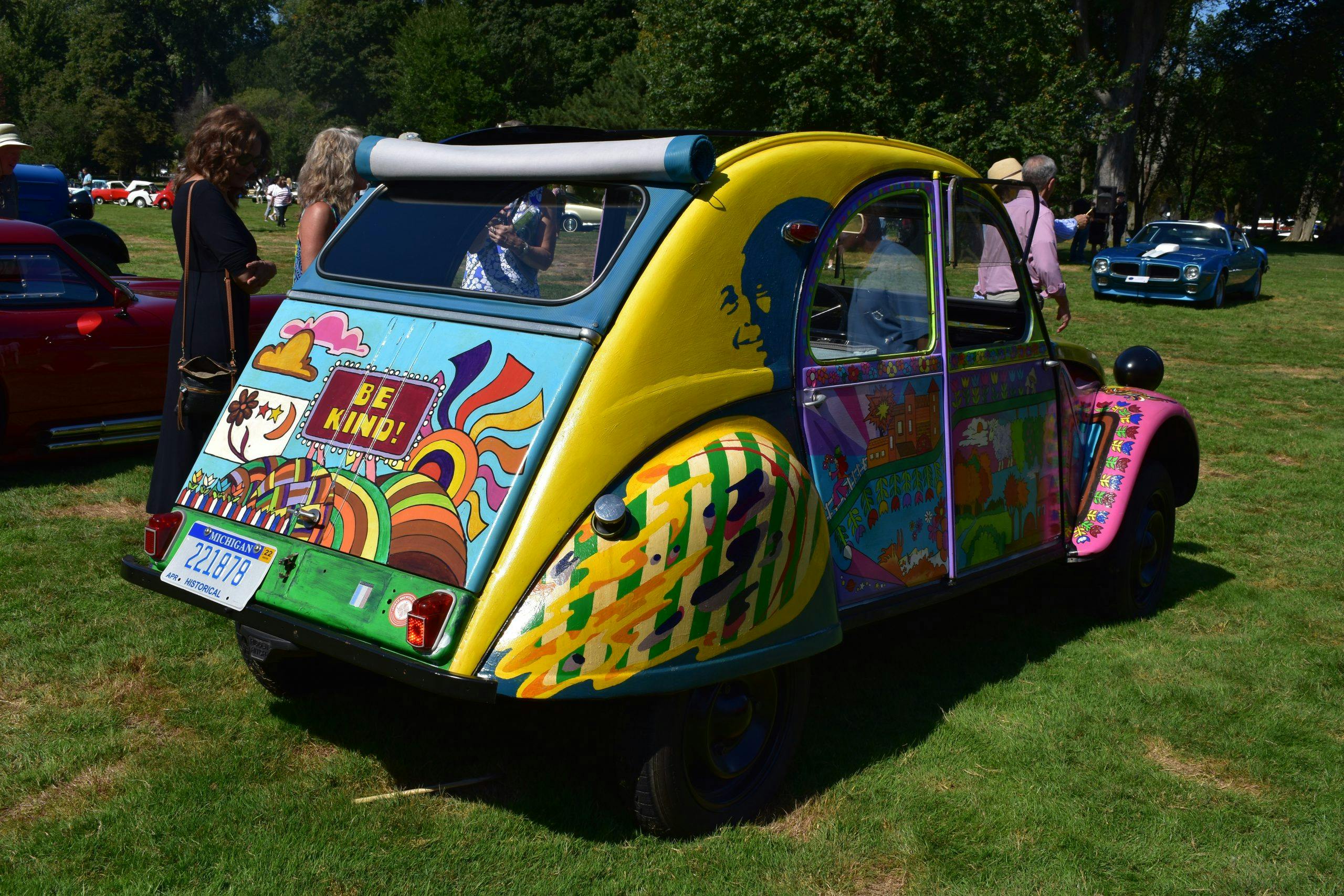







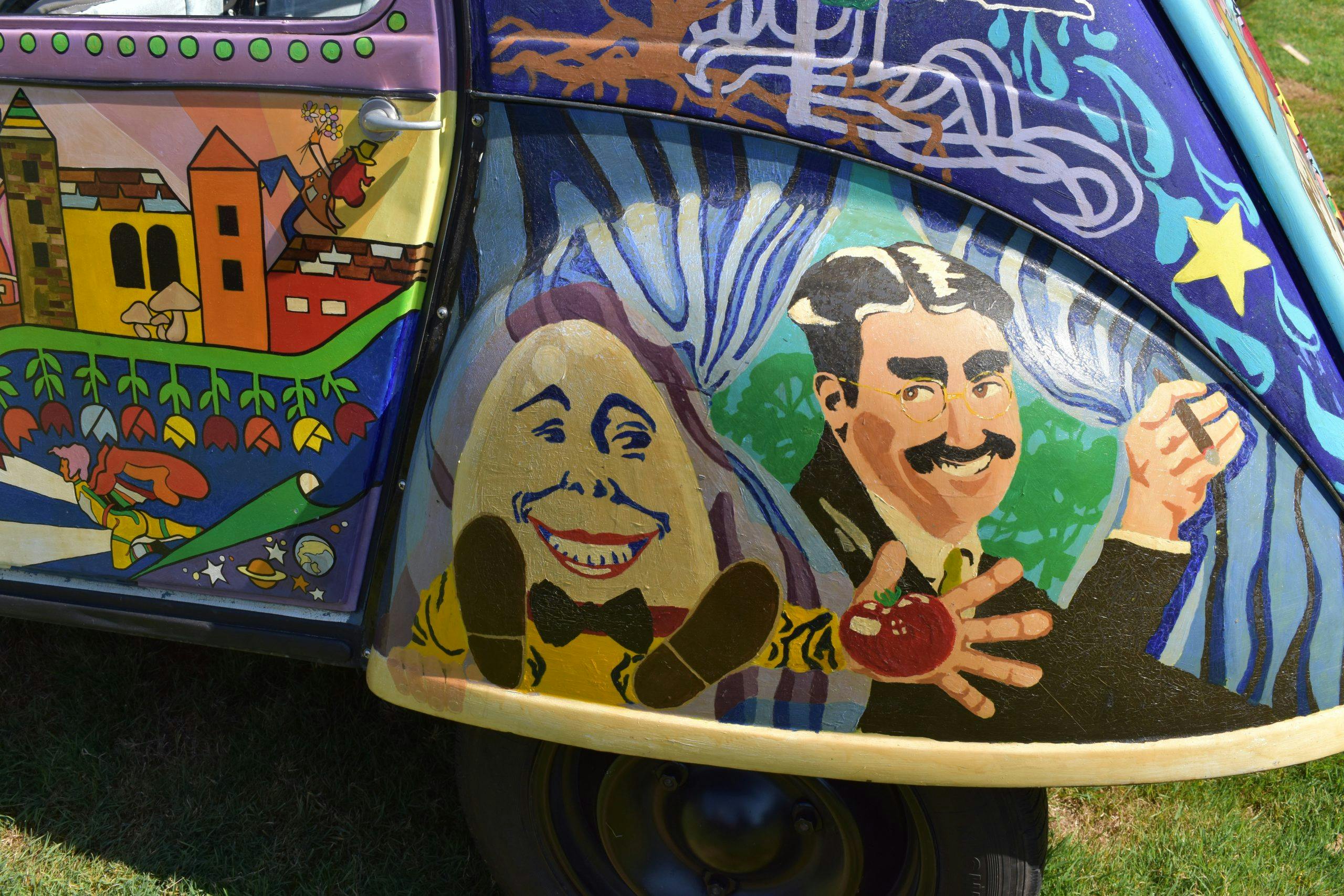


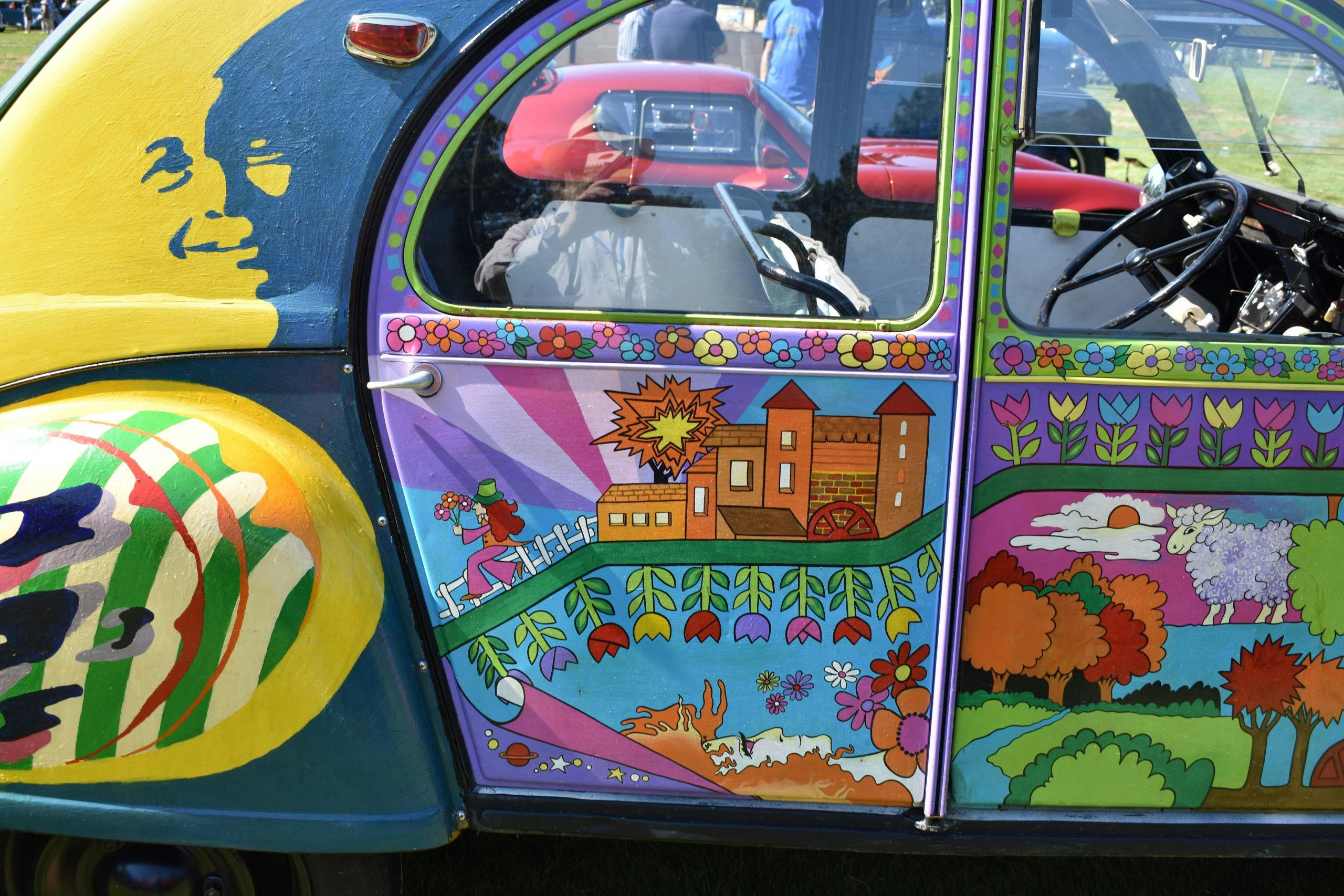





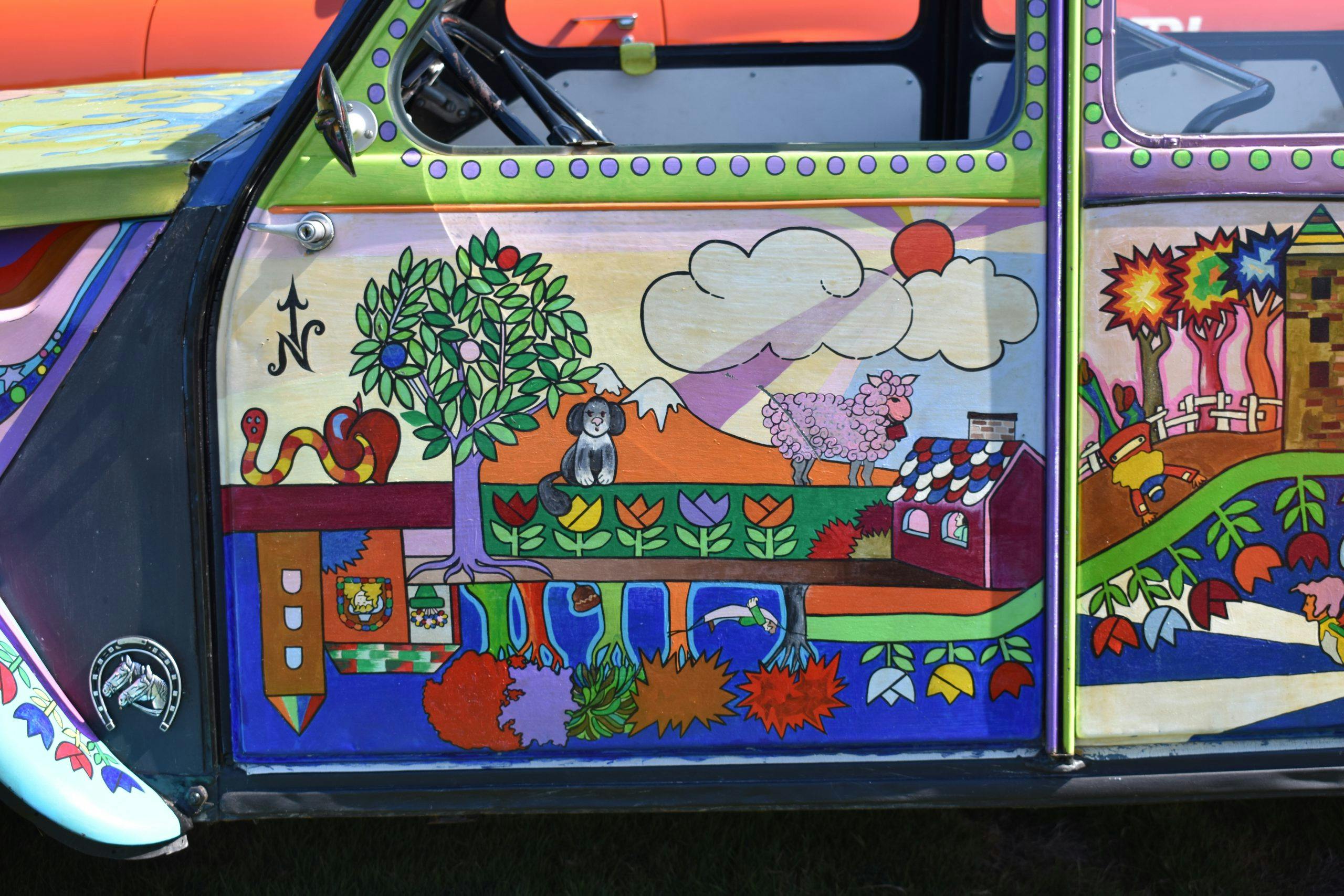
















































Great article. Wish I was the one who found that yellow Sonett II. : )
Excellent story, that made my day!
Interesting story. Not my kind of car. I’m more interested in the Saab.
What a perfectly wonderful tale! Hope this Deux Cheveux stays around for a long, long time!
Not a Sonett II, which has a 3-cylinder 2-stroke engine and no hood bulge, but a Sonett V4 (not Sonett 4) with the German Taunus V-4 engine. I have one.
Wonderful,uplifting story,which MIke told me a while ago after he contacted me when I posted photos of my own hippie 2cv which I painted myself.I’m also an artist and as a hobby have since painted several clasic cars in my unique hippie style and sold them on,however I will never sell my 2cv and maybe after I pass on all my painted cars will be worth some money to the owners.